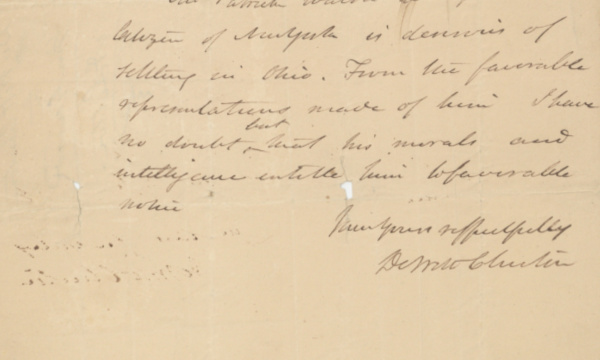DeWitt Clinton Letter, 1817, Recommending a Man Going to Settle in Ohio.


It was for such settlers that Clinton promoted the Erie Canal
- Currency:
- USD
- GBP
- JPY
- EUR
- CNY
American politician who served as a United States senator, as mayor of New York City, and as the seventh governor of New York. In this last capacity, he was largely responsible for the construction of the Erie Canal. Clinton was a major candidate for the American presidency in the election of 1812,...
American politician who served as a United States senator, as mayor of New York City, and as the seventh governor of New York. In this last capacity, he was largely responsible for the construction of the Erie Canal. Clinton was a major candidate for the American presidency in the election of 1812, challenging incumbent James Madison.
Autograph Letter Signed, Albany, September 5, 1817 to early Ohio settler and War of 1812 General John Gano, Clerk of the Ohio Supreme Court, recommending a potential settler in Ohio. “Mr. Patrick Walsh, a reputable citizen of New York is desirous of settling in Ohio. From the favorable representations made of him I have no doubt but that his morals and intelligence entitle him to favorable notice.”
As governor, Clinton was largely responsible for the construction of the Erie Canal. He was persuaded by Canal proponent Jesse Hawley to support construction of a canal from the eastern shore of Lake Erie to the upper Hudson River. Many thought the project to be impracticable, and opponents mocked it as “Clinton’s Folly” and “DeWitt’s Ditch”. But in 1817, he persuaded the legislature to appropriate $7 million for its construction. When the canal was finished in 1825, Clinton opened it and traveled in the packet boat Seneca Chief along the canal to Buffalo. This canal made it much easier for people to travel from the eastern U.S. to the western frontier, just as Mr. Walsh planned. It was undoubtedly people like Walsh who helped Clinton decide the canal was needed.

Frame, Display, Preserve
Each frame is custom constructed, using only proper museum archival materials. This includes:The finest frames, tailored to match the document you have chosen. These can period style, antiqued, gilded, wood, etc. Fabric mats, including silk and satin, as well as museum mat board with hand painted bevels. Attachment of the document to the matting to ensure its protection. This "hinging" is done according to archival standards. Protective "glass," or Tru Vue Optium Acrylic glazing, which is shatter resistant, 99% UV protective, and anti-reflective. You benefit from our decades of experience in designing and creating beautiful, compelling, and protective framed historical documents.
Learn more about our Framing Services










































































































